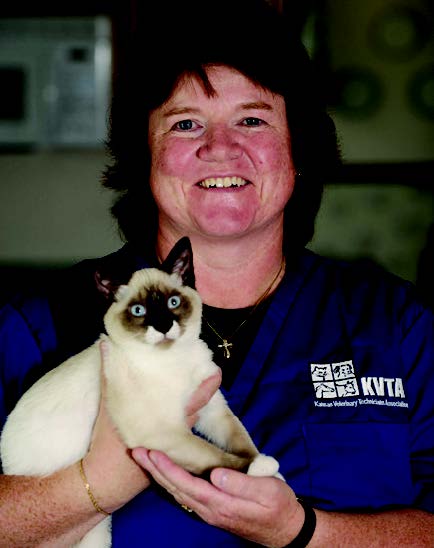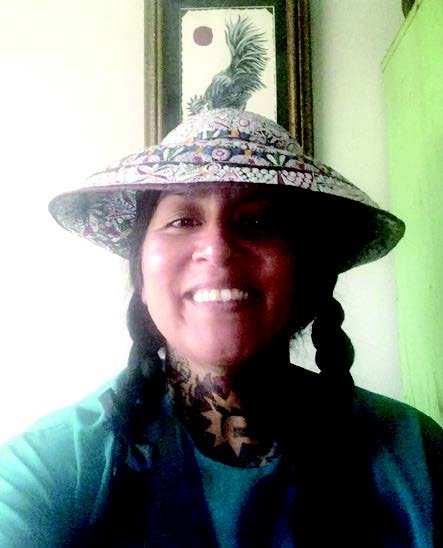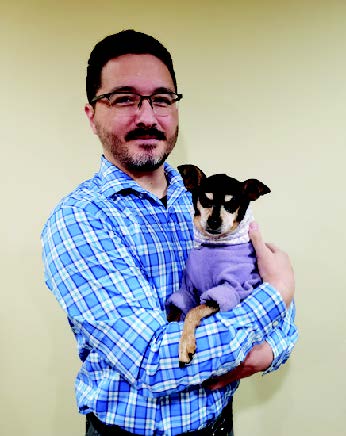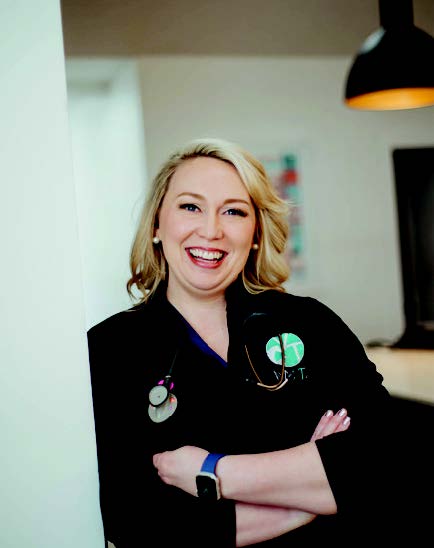Technicians Making a Difference
Leaders Who Are Moving the Profession Forward
by Constance Hardesty
Working for statewide credentialing. Establishing advanced specializations. Crafting a unique career path. Promoting the state association. Partnering for education. Envisioning the future. In private practices, universities, professional organizations, or legislatures or blazing their own trail, veterinary technicians are shaping the future of the profession.
The following article is a series of interviews with veterinary technicians who are breaking new ground and moving the profession forward in different ways. Their stories are inspiring. Their shared secret: If we can do it, so can you.
Kara Burns, MEd, MS, LVT, VTS (Nutrition), VTS-H (Internal Medicine, Dentistry)
 Background: Past president, NAVTA; Founder, Academy of Veterinary Nutrition Technicians; Director of Veterinary Nurse Development, WellHaven Pet Health, Vancouver, Washington
Background: Past president, NAVTA; Founder, Academy of Veterinary Nutrition Technicians; Director of Veterinary Nurse Development, WellHaven Pet Health, Vancouver, Washington
CH: You’ve been around the veterinary technician profession for a while. What is the most significant change you’ve seen?
KB: Increased technician utilization. We are at a place now where the veterinary profession recognizes the benefits of utilizing technicians to their fullest extent. I have said many times that utilizing your veterinary teams appropriately brings revenue to the practice, builds morale, decreases burnout and turnover, and is good medicine.
CH: One initiative that has gained ground is specialty credentialing. For technicians in general and for you personally, how does a specialty credential enhance professional fulfillment?
KB: Twenty-five years ago, the Academy of Veterinary Emergency and Critical Care Technicians was the first specialty academy recognized by NAVTA. Fast forward to 2021, and our profession now has 16 veterinary technician specialties! Specialization allows veterinary technicians to follow their passion and attain a higher level of recognition for advanced knowledge and skills.
From my first day in veterinary medicine, I loved nutrition. As I saw it, if I was going to provide the best for my patients, nutrition was a no-brainer.
 Seeing the advent of vet tech specialties, I knew there had to be one for nutrition—and nothing was going to stop me from making it a reality! It took a great deal of work and some exceptional individuals on the organizing committee (and support from family and colleagues), and in 2010, the Academy of Veterinary Nutrition Technicians (AVNT) was recognized. For me this was professionally and personally fulfilling—a legacy, if you will.
Seeing the advent of vet tech specialties, I knew there had to be one for nutrition—and nothing was going to stop me from making it a reality! It took a great deal of work and some exceptional individuals on the organizing committee (and support from family and colleagues), and in 2010, the Academy of Veterinary Nutrition Technicians (AVNT) was recognized. For me this was professionally and personally fulfilling—a legacy, if you will.
CH: You’ve been an advocate for technician credentialing and specialties. Can veterinary technician salaries support the debt that higher education, particularly a four-year degree, entails?
KB: The bottom line is that vet techs’ debt coming out of college with an associate’s degree or bachelor’s degree is similar to veterinarians’ debt. Vet tech education obviously does not cost as much as a DVM education, but vet techs coming out of school have the same difficulty paying their loans due to the low wages they are paid.

"Specialization allows veterinary technicians to follow their passion and attain a higher level of recognition for advanced knowledge and skills."
—KARA BURNS, MED, MS, LVT, VTS (NUTRITION), VTS-H (INTERNAL MEDICINE, DENTISTRY)
If we could increase credentialed technician utilization and have veterinarians do the things that only they are licensed to do while allowing technicians to work at the top of their license and education level, we could start to see increased revenue, job satisfaction, and pay (for vets and techs), plus best medical practices. Until we techs are truly utilized, we will continue to see low wages, turnover, decreased morale, and medicine that is not being performed as best practice.
CH: You’re currently a director of veterinary nurse development. What do you hope to achieve?
KB: Veterinary nurse development involves empowerment, utilization, education, mentoring, and respect for veterinary nurses and technicians and all they can do.
My vision is to ensure my veterinary nurse colleagues are being utilized fully and properly. To do that, they need to feel confident in their skills and knowledge, communicate with their veterinary teammates, and discuss and exemplify the incredible value they bring to the team. Professional development of the “other” clinical skills (like communication and leadership) is just as important as the technical skills. We will start with implementing a nutritional counselor program that will develop the knowledge, communication, and skills involved in nutritional assessments. This is one area of medicine where veterinary nurses and technicians can utilize their skills, demonstrate confidence, improve their communication skills, bring in revenue, and, most importantly, provide great nursing care and medicine.
In addition, we will provide hands-on training for other skill sets for which veterinary nurses should be taking the lead, including dentistry and anesthesia. By providing this, along with building knowledge and confidence, we will be able to ensure that veterinary nurses are working at the top of their credential and veterinarians are doing only those things that veterinarians are licensed to do. It is a win for everyone, most importantly, the pet!
Lizett Gutierrez, LCSW, MA, RVT
 Background: 2018 Excellence in Research Award; Institute for Human-Animal Connection; Licensed Clinical Social Worker; bilingual home-based clinician; Mental Health Center of Denver
Background: 2018 Excellence in Research Award; Institute for Human-Animal Connection; Licensed Clinical Social Worker; bilingual home-based clinician; Mental Health Center of Denver
CH: As a veterinary technician, educator, and veterinary social worker, your career is self-leadership at its best. What’s your story?
LG: Perseverance. The field of animal-assisted social work and veterinary social work were nonexistent in my 18 years as a veterinary nurse. I planted seeds and then the harvest came.
CH: You went back to school, and after earning your master’s degree in special education, you had an epiphany.
LG: It made sense to pursue a master’s in social work (MSW) at the University of Denver because they offer a certificate in animal assisted social work. This meant reaching people on a clinical level by enhancing their connection to the human-animal bond.
CH: At DU, you earned a master’s degree in social work and received the Excellence in Research Award. Tell us about that.
LG: I received the Excellence in Research Award for my work on both the Green Chimneys and Pets for Life projects. IHAC provided me with the opportunities to utilize my special education training and engage in community social work.
CH: The master’s degree qualified you for the University of Tennessee’s postgraduate veterinary social work program, where, again, you worked to improve access to veterinary care.
LG: The VSW Certificate program at the University of Tennessee is self-paced for working professionals. It connected me to the AlignCare program where I assisted qualifying families with financial support for their pets’ sick/injury care.
CH: What is veterinary social work?
LG: Veterinary social work (VSW) is a specialized field that provides clinical therapeutic support to anybody who has a role in helping pet(s) and their people.
CH: Veterinary technicians leave the profession due to compassion fatigue and burnout, like you experienced. How can practices promote a healthy work environment?
LG: Without support, you’re going to lose technicians. It’s not the kind of thing that can be fixed in a couple of team-building exercises. I’d like to see greater access to mental health services for veterinary technicians.
Some, if they are lucky enough, work in practices that offer an employee assistance program (EAP), but many don’t.
CH: Racism is one stressor that is gaining mainstream attention. From your perspective as a mental health worker, how can veterinary professionals respond?
LG: To say these are tense and stressful times would be an understatement. You have to dig in and realize that the person making the comment does not know you, your unique self, or your background. CH: What’s next for you?
LG: To continue to build on my capacity as a bilingual veterinary social worker who can address the needs of veterinary staff utilizing a trauma-informed approach and training in substance abuse.
Dru Mellon, RVT, CVT
 Background: 2020 National Association of Veterinary Technicians in America (NAVTA) Veterinary Technician of the Year; Secretary, Utah Society of Veterinary Technicians and Assistants; veterinary technician, Mountain West Veterinary Specialists, Layton, Utah
Background: 2020 National Association of Veterinary Technicians in America (NAVTA) Veterinary Technician of the Year; Secretary, Utah Society of Veterinary Technicians and Assistants; veterinary technician, Mountain West Veterinary Specialists, Layton, Utah
CH: You were instrumental in getting technician certification passed in Utah. Briefly, what does the Utah rule require?
DM: To become a credentialed technician, one must either graduate from an AVMA-accredited program (or apply through the alternate route, which requires three years of full-time experience), and then pass the Veterinary Technician National Exam (VTNE). Once certified, continuing education (CE) requirements (a minimum of 12 hours every 2 years) go into effect.
CH: How does state certification benefit technicians?
DM: One of my main goals was to help veterinary technicians be utilized to their fullest extent. I want every technician to be able to feel enriched by the job. We lose so many veterinary technicians to burnout, and I wanted to try to give people a reason to stay.
I believe that if veterinarians dealt with more veterinary technicians who have been more fully trained and educated, then they would be able to trust us to do our jobs. This, in turn, frees them up to do theirs.
CH: Starting with advice from a mentor, you reached out to the state VMA, completed the paperwork to launch a bill in the state legislature, and even spoke at legislative committee meetings. What did you learn from the process?
DM: It takes a community for something like this to happen. When I joined up with the Utah State Veterinary Technicians Association (USVTA), Michiko Berceau had been driving the organization forward for years without me. And she was just one of multiple people who took it upon themselves to work together to create it years before. It took my former mentor, Ken Yagi, to provide the information and contacts I needed within NAVTA and the Veterinary Nurse Initiative (VNI). Without the wealth of information that they continuously shared with us, I would never have known what to ask for or avoid when it came to creating credentialing guidelines. When the Utah Veterinary Medical Association (UVMA) asked us what we wanted credentialing to look like, I wouldn’t have had an intelligent answer to give them.
In Utah, we’re exceedingly fortunate to have a champion for veterinary technicians in the UVMA. Without their support, the conversation about credentialing could have stalled. If it wasn’t for their help, we’d still be knocking on doors at the state legislature to find a sponsor.
Furthermore, one of the things the congressional committee loved was that the UVMA and USVTA came forward together to support this. Without their support, even if a bill gets drafted, will it pass through the committee? I honestly don’t know. It took the strength and passion of the entire veterinary community for credentialing to happen in Utah. This is an accomplishment for and by all of us.
CH: What was most challenging or difficult about the process and how did you handle it?
DM: The most personally challenging aspect of all of this for me is the fact that I suffer from social anxiety.
From joining the USVTA’s board, to attending UVMA board meetings and introducing myself to a group of veterinarians that represent the entire state, to speaking before congressional committees (some of whose members do not believe in creating more restrictive legislation), the whole process was an exercise in fighting back my screaming brain and ignoring my wrenching guts so I could stand up for my fellow technicians.
This peaked the moment when, at the first congressional committee meeting, I saw that the committee was on the verge of rejecting the bill, preventing it from going to the House floor for a vote.

"I believe that if veterinarians dealt with more veterinary technicians who have been more fully trained and educated, then they would be able to trust us to do our jobs."
—DRU MELLON, RVT, CVT
The initial version of the bill was planned to be more restrictive than what was ultimately implemented. At the time, the goal was to create full licensure, which would create title protection and a limited scope of work, restricting certain tasks only to credentialed technicians.
The majority of the committee was already opposed to creating more restrictive laws in general, and they specifically worried this would prevent some veterinary practices (particularly rural ones without credentialed staff) from being able to work.
The bill was on the chopping block, and I saw the entire effort slipping through my fingers.
But at the last moment, one committee member suggested we pursue state certification instead rather than full licensure. By Utah legal definitions, this creates an elevated position within a profession without restrictions on others working within it. Everyone looked at me immediately for an answer, and the choice was in my hands. I had seconds to decide: either insist on full licensure and see the bill killed in committee (with no promise we would have another opportunity any time soon) or accept the compromise of certification. As everyone knows now, I accepted the compromise; but the anxiety of that decision has never left my shoulders.
CH: What would you say to other technicians who would like to advance the profession?
DM: Become a member of your professional organization and get involved! Sometimes it’s easy to think organizations like the USVTA or NAVTA are some sort of monolith with endless resources and people behind them, but these groups are truly only as strong as their members. The USVTA struggles to maintain a full executive board year after year, and membership fees are our primary source of funding. A single person can make a huge difference!
Ashli Selke, CVT
 Background: President-elect of NAVTA; Director of Marketing for the Arkansas Veterinary Technician Association (AVTA); Clinical Lab Coordinator/Distance Learning Instructional Technologist, Purdue University College of Veterinary Medicine
Background: President-elect of NAVTA; Director of Marketing for the Arkansas Veterinary Technician Association (AVTA); Clinical Lab Coordinator/Distance Learning Instructional Technologist, Purdue University College of Veterinary Medicine
CH: How did you get started in veterinary leadership?
AS: I became involved in 2016 after attending the veterinary technician track put on by the Arkansas Veterinary Technician Association (AVTA) at the Arkansas Veterinary Medical Association’s (ArVMA) winter meeting. I knew that being a veterinary technician in multiple states meant I could bring a lot of knowledge to the table. In 2016 I became the director of marketing, and that role led me in 2018 to being the NAVTA District 8 Representative for Texas, Louisiana, and Arkansas. Constance Hardesty, MSc, is a writer and freelancer living in Colorado. She is a former editor-in-chief at AAHA.
As the director of marketing from 2016 to 2021, I designed a new website with an online membership application/renewal process and a digital payment system using debit or credit cards. The result was better cash flow and a major increase in non-dues revenue.
Two years ago, AVTA became the first veterinary technician association to partner with five veterinary state boards (New Mexico, Texas, Oklahoma, Louisiana, and Arkansas) to produce the Southwest Veterinary Symposium (SWVS). The SWVS is a continuing education event, with all profits returned to the partnering states. Since then, the Texas and Oklahoma VTAs have joined the effort.
CH: You were also involved in technician credentialing in Arkansas.
AS: I became involved because I wanted to have a voice in my profession. I wanted to create relationships with the state board so that when decisions were made, technicians had a seat at the table.
CH: You have a passion for mentoring. What does that look like for you?
AS: I have helped middle schoolers 3D-print a prosthetic limb for their STEM project, gone to high schools to speak about the veterinary profession on career days, and helped with a 4-H summer camp.
I have offered one-on-one mentoring and coaching for online students from different programs.
I also volunteer on various committees at the national and state levels. Finally achieving an optimal work-life balance, I am able to speak and attend conferences to reach more of those in the field.
At Purdue University, I mentor on-campus and distance-learning students by always lending an ear. My office is always open to anyone. Being in an academic environment, I am able to share my experience and expertise with potential vet techs, to help them understand the “why’s” of the profession and how to navigate their careers.
CH: What would you say to technicians who want to do their part to advance the profession?
AS: Be involved! Be involved in your community, and at the state and national levels. Lend your expertise to organizations and associations. If you are not a member of your state or national association, most likely your voice is not being heard. Associations are there to amplify the veterinary technician and nurse voices and move our profession forward the way that we want. #Progression4ourProfession
Most importantly: Be kind! Be kind to your trainees, peers, coworkers, and DVMs. Especially now, as our profession is in a state of continued overload, burnout, and compassion fatigue. Kindness goes a long way.
 |
Constance Hardesty, MSc, is a writer and freelancer living in Colorado. She is a former editor-in-chief at AAHA. |
Photo credits: FatCamera/E+ via Getty Images; Kara Burns, MEd, MS, LVT, VTS (nutrition), VTS-H (Internal Medicine, Dentistry) (Photo courtesy of Kara Burns); santypan/iStock via Getty Images; Lizett Gutierrez, LCSW, MA, RVT (Photo courtesy of Lizett Gutierrez); Dru Mellon, RVT, CVT (Photo courtesy of Tammy Mellon); SDI Productions/E+ via Getty Images; Ashli Selke, CVT (Photo courtesy of Rouge Art Photography)



